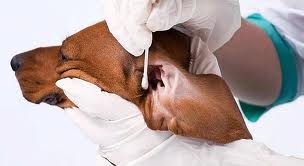Many dogs suffer from an ear infection at some point in their lives. In fact, ear infections are the most common types of diseases that veterinarians treat. Canine ear infections are not usually life-threatening, but they are uncomfortable for dogs.
A dog’s ear is comprised of three main parts: the inner ear, middle ear and outer ear. Any of these parts can become irritated or inflamed for various reasons.
Symptoms
A canine ear infection can present several symptoms. The most common one is the shaking or tilting of the dog’s head. Dogs may also scratch their ears frequently. The ear may have a strong odor. Upon inspecting the ears, you may notice that they are red or swollen. There may be hair loss or scabs on the ear. There may also be yellow or black discharge. In rare instances, the dog may seem unbalanced or walk in circles. In extreme cases, the dog may exhibit unusual eye movements or lose their hearing.
Causes
Canine ear infections have many causes, but a high percentage can be traced to yeast and bacteria. Hair in the ear can cause bacteria to grow, as can ear mites and tumors. Water trapped in the ear can lead to ear infections, so dogs that bathe or swim frequently have a higher risk of developing them. Ear wax, allergies and hypothyroidism have also been known to cause canine ear infections.
Diagnosis
It is important have a veterinarian diagnose and treat your dog’s ear infection. Self-treatment can cause the infection to worsen and possibly cause deafness in your dog. The veterinarian will inspect the ear drum and ear canal under anesthesia. If discharge is present, the veterinarian may take a sample and have it inspected for bacteria or mites. Allergy tests and lab work may also be needed, depending on your dog’s health situation.
Treatment
It is important to see a veterinarian as soon as you notice any of the symptoms, as ear infections are very painful for dogs. Your veterinarian will clean the ears thoroughly in the office and may schedule follow-up appointments to perform further cleanings. The veterinarian will prescribe medications for you to administer to your dog. This may be an ointment or ear drops. In some cases, antibiotics, anti-inflammatory or anti-yeast medications may need to be given orally. Extreme cases of canine ear infections may require surgery.
Prevention
There are many things you can do prevent canine ear infections.
- Inspect the dog’s ears often for any unusual signs, such as redness, swelling or discharge.
- If your dog has had multiple ear infections, check with your vet about an ear-drying solution to prevent future cases.
- Dry your dog’s ears thoroughly after swimming or bathing.
- If your dog grows hair inside the ears, remove it with tweezers or ask the vet to do so.
- Dogs with floppy ears are more susceptible to ear infections, so if your dog has this kind of ears, pay extra attention to them.
The ASPA website has an information video that shows you how to clean your dog’s ears at home.
